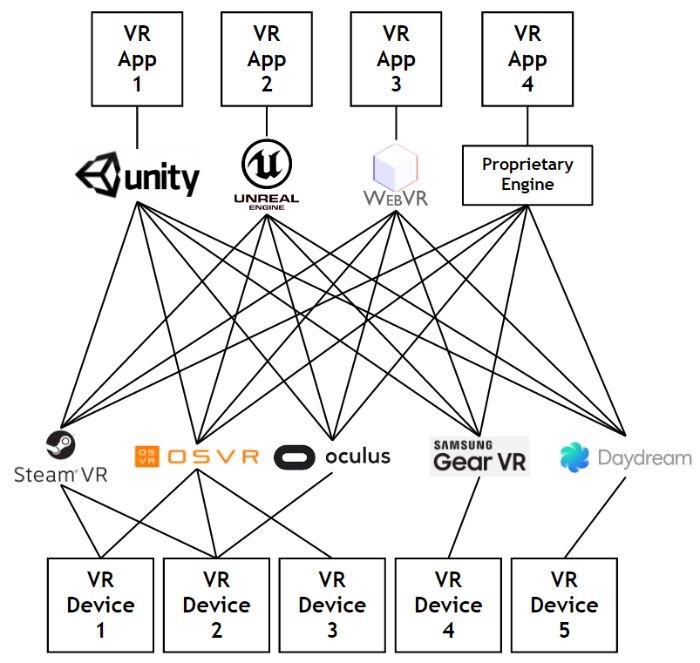Imagine you bought a new printer for your office. You connect it to your PC, install the demo software, and make sure it is working properly. Then suddenly you discover: The word processor is not compatible with this printer. So you have to wait for the word processor manufacturer to release a new version. But when should you wait? Should you return this printer? Or should you use another word processor?
Although this may seem like a scene in the 1980s, for virtual reality, this is exactly what we face today. Industry analysts and the media have been speculating whether the VR industry will really take off. But as the "Financial Times" recently reported: "So far, the VR market has not developed as expected." One of the biggest problems faced by VR is that VR experiences are often hard-coded and only compatible with a set of hardware devices.
Only certain VR devices, tracking systems, and controllers can run a particular VR experience. If you want to play a VR experience with different VR hardware, this is usually not possible. For emerging markets such as VR, this may seriously hinder the popularity of consumers.
Should the industry try to solve this problem? Some people claim that because VR is a new thing, these problems are inevitable and will eventually be resolved naturally. Some people also "oppose" to solve this problem. A vendor adheres to a "walled garden" strategy (controlling and limiting user choices) and uses this issue to dominate the market. Allowing consumers to use different VR hardware or other app stores may not be in their plan.

1. Standards require a unified API
Most people think that the success of the VR industry depends on quickly solving this problem. The market needs to establish standards for the VR industry to overcome this problem that hinders popularization.
This method works well in many other technology markets. For example, if you have a Dell computer, you can use a non-Dell printer. This also applies to devices such as keyboards, mice, and scanners. All of these can be mutually compatible with specific standards. But now, a VR system can only be compatible with consistent heads-up displays (HMDs), trackers, and controllers. A completely new standard that is compatible with various VR devices is the key to the market's booming in the coming years.
Almost everyone will benefit from a standard. If VR software is compatible with different hardware combinations, consumers can assemble the device according to their preferences and prices. They can also ensure that their investment in VR will not be out of date. What players want to see is that a 2017 game is compatible with 2018 or 2019 hardware.
In addition, game publishers and other experience developers will find a larger target market. Today, developers hard-code their games to a specific set of hardware devices. But tomorrow, they can develop applications for any device that has a consistent "driver." Finally, vendors that support standards will find that their hardware is compatible with more content. In this way, even small players can enter the market because their consumers have immediate access to their content. In short, standards can promote innovation rather than spending time on the evolving device API.
Basically, this is good for all parties. But what are these standards like and how can they be implemented?

2. Standards promote innovation
In VR and AR, the elements that need to be standardized are device interfaces and application interfaces. The device interface standard will define how to configure a particular type of VR device and how to extract data from it. For example, printers and printers have different functions, but their basic functions are the same. The same is true of VR devices. The application interface standard will describe how a VR application or game engine renders its content and receives data. If these two core elements are standardized in all VR hardware and software products, then the popularity and innovation of the industry will proliferate.
Fortunately, some organizations have begun to address the VR industry standardization tasks. For example, OSVR achieves unity of the device interface layer and application layer, supports hundreds of devices, and most of the OSVR code is free and open source. In addition, OpenVR is Valve's open API (although not open source), allowing all VR devices to use SteamVR content.
In January of this year, Khronos launched a VR project called OpenXR, which has been supported by many tech giants, including Google, Intel, Facebook's Oculus, Valve, Samsung, Nvidia and AMD. They all want to set new standards for device interfaces and application interfaces.
This is evolving into a trend, but we still have a long way to go. Without a uniform standard, the VR industry may be very unstable. This is also a key factor for popularization, which can improve the experience of VR users and promote key innovations to achieve a VR market.
Wire harnesses are commonly used in the electronics industry, the automotive industry, in the manufacture of construction machinery and industrial equipment, as well as in the manufacture of white goods such as washing machines and dryers, refrigerators, and other household appliances.A industrial wire harness is typically designed to simplify the manufacture of a larger component, and is designed based on the geometric and electrical requirements of the equipment it is to be installed in.
Industrial Cable Harness,Mechanical Cable Assembly,Industrial Cable Harness,Mechanical Cable Assembly,Accessories Service
ETOP WIREHARNESS LIMITED , https://www.wireharness-assembling.com